AudioCulture
The noisy library of New Zealand music
Te pātaka korihi o ngā puoro o Aotearoa
Doublehappys
95bFM, the Auckland University student radio station, has caught former Doublehappy Shayne Carter on an honest day in 2012. Class was not something the 1980s indie music scene dwelt on. Socio-economic tensions and differences existed, but more often as personal rather than group motivation.
Mostly you found your allies where you found them in the late 1970s and early 1980s. In the Doublehappys' case, it was among their neighbourhood friends and in the wider creative other of Dunedin’s punk and post-punk community, many of whom were or would soon be students at Otago University.
Smart working class and lower middle class kids went there as well. The high wooden doors of the grey stone university weren’t closed to them, but those paths were both constricted and well trodden. Punk rock offered a freer, more exciting alternative, and opened up a cultural space where creative challenge was the norm.
The Doublehappys were two then three subversively intelligent Dunedin teenagers from the wrong side of the hill.
The Doublehappys story more commonly told is one of humour and pathos and music with enough power that it still kicks hard and tuneful in contemporary times. But that too is only part of the story.
While laughter was a tonic they drank deeply of, it ultimately obscured as much it revealed. The Doublehappys were two then three subversively intelligent Dunedin teenagers from the wrong side of the hill, who seized the moment and rode it for all they were worth until numbing tragedy stopped them in their tracks.
Who killed Bored Games?
In 1982, Dunedin music commentator Roy Colbert was given charge of The NZ Listener’s Soundcheck column for a short series of articles focusing on the rising indie music movement in the South Island. For those outside Dunedin, it was the first detailed insight into not just the present, but also the immediate past of that community.
With Flying Nun Records already harvesting Dunedin’s punk-prodded and 1960s fixated music, there was much to report. In a page-length piece about the release of Dunedin teen punks Bored Games’ retrospective EP, Colbert noted that “(Shayne) Carter, possibly too abrasive to be accommodated in the continual cross pollination that has gone on in the Dunedin bands these past eighteen months, has been fiddling with guitars and talks of having a new band soon.”
Carter had in fact been in at least two post-Bored Games groups already. Sparkling Whine flared to live performance at the Empire Tavern before disbanding in late 1981. A second band with Myles White from Heavenly Bodies seemed to barely get going. Carter and Peter Gutteridge’s The Carterlidge Family had a little more fuel in their tank. Period recordings of the group reveal Shayne Carter upfront with the mannered vocal he’d soon abandon on hooking up in late 1983 with Wayne Elsey, bass player in early Bored Games and guitarist and co-vocalist of The Stones.
Anyone Else Would
Doublehappys, as the duo named themselves, was at first just Carter and Elsey and a Casiotone drum machine with three useable beats – fast rock, slow rock and samba – called Herbie F**kface.
With the Dunedin indie scene hitting its stride, Doublehappys weren’t short on shows. In early October 1983, they shared the Empire stage with Martin Phillipps and David Kilgour, before returning the next month with Bill and Carol Direen, then David Kilgour and The Newbergs.
Christchurch beckoned in mid-December, where Doublehappys appeared alongside The Bats, Children’s Hour, They Were Expendable, Scorched Earth Policy, Say Yes To Apes, The Axemen and The Haemogoblins at Flying Nun’s Recording Party at the DB Gladstone.
Back in Dunedin, the Doublehappys' clattering punk sound spewed from the faithful Empire’s stage on a bill with Martin Phillipps’ A Wrinkle In Time. They saw out 1983 at the same venue with The Great Unwashed.
With new songs emerging, Carter and Elsey decided to get them down on 2-track with Terry Moore at their Roslyn Mills practice room. It turned out to be a smart move as the drum machine demos helped Doublehappys to secure their next big break. Of the songs captured, the snappy ‘Barbie Bites You To Bits’ and ‘Wrapped Up In Myself Again’ featured on Every Secret Thing’s March 1984 tape compilation, Songs From The Lowland.
Eight years on, two of the recordings were compiled on the Doublehappys’ Nerves collection, released in NZ and Australia in 1992. The snotty, Elsey-sung ‘I Can’t Say’ sports a “garage punk-ish whine and narrative,” Carter remembered, while his ‘Wrapped In Myself Again’ was similarly spirited.
Meanwhile, drummer Herbie was playing up, throwing a few wobblies and overshooting song endings as he did supporting The Gordons at The Captain Cook. Herbie had served his purpose. A human, who could speed up and slow down and stop on time, was now needed.
Colquhoun Street, Glen Ross, Dunedin
Dunedin’s Kaikorai Valley High School produced a raft of new drummers in the early 1980s with Jeff Harford providing the beat for Bored Games, then The Rip, Lesley Paris in Look Blue Go Purple, Martin Durrant in Sneaky Feelings and Graeme Anderson in The Stones.
Elsey would stick an amp in the drive when The Stones rehearsed and the sound would reflect off the little valley where they lived.
New Doublehappys drummer John Collie was a childhood friend of Wayne Elsey’s from Colquhoun Street in Glen Ross in South Dunedin. Teenage punks Bored Games practised in Elsey’s parents’ garage at the bottom of the road and Collie would sometimes slip behind Jeff Harford’s kit. He did the same when The Stones rehearsed at Graeme Anderson’s Colquhoun Street house or they’d practise together. Elsey would stick an amp in the drive when The Stones rehearsed and the sound would reflect off the little valley where they lived. “No wonder I failed UE (University Entrance) that year,” Collie joked in 2012.
The three-piece Doublehappys didn’t have long to jell. The 2-track demos had secured them a spot on Flying Nun Records’ groundbreaking showcase Looney Tour alongside The Chills, The Expendables and Children’s Hour. Beginning in mid-February 1984 in Dunedin, the four groups crawled their way up the islands in a ragtail of vehicles before ending up in Auckland in mid-March, where the Doublehappys were due to record a single with Terry Moore at Lab Studios.
Double B Side
The Looney Tour hit Hamilton in the first week of March 1984. The word on the indie grapevine that preceded them was that the Doublehappys were slaying audiences with a 10-song set that they didn’t rotate.
The first of the two Hamilton shows at Waikato University was sparsely attended, which didn’t stop Elsey and Carter taunting the audience about the region’s preferred sport. ‘They’re all rugby players up here,” Carter told Elsey onstage, sparking an impromptu take on the theme music to The Big Match, the English soccer highlights show hosted by Brian Moore that played in New Zealand on weekend mornings. They were more restrained later that evening, sitting rolling joints in a Hamilton east rental house as the rest of the Loonies tried to spark a party in the tiny living room.
Five songs from the Doublehappys’ Windsor Castle dates later that week, ‘Big Fat Elvis’, ‘Beer Cans On The Ground’, Guilt,’ ‘I Don’t Wanna See You Again’ and ‘Anyone Else Would’ were captured by Nocturnal Projections drummer Gordon Rutherford on 4-track. They would turn up as the How Much Time Left Please? EP on Scottish label Avalanche Records in 1991.
With Terry Moore’s Lab Studio recorded takes of Elsey’s ‘Anyone Else Would’ and Carter’s ‘The Other’s Way’ in the can after a six hour session, Doublehappys headed home again for mid-March shows at the Empire Tavern with The Rip. On May 1st, they put their sparkly face on for a Glitter Party with Look Blue Go Purple at the Captain Cook.
The Other’s Way
On June 17, 1984, the Doublehappys were in familiar space as part of a Flying Nun related bill at Otago University with The Verlaines, Look Blue Go Purple and The Chills. It was a bit of the (not so) old alongside a bit of the new. Come late August, the terrible trio were back on the road to Christchurch, where they were headlining a weekend at the Star and Garter and filming a video for ‘The Other’s Way’ with Robin Neate.
Richard Langston from Dunedin fanzine Garage was there for the filming, in The Great Unwashed’s practice room in a Christchurch warehouse. Under the headline "Boys On Film", the first issue of Garage reported, “A friend of the band coughed up a $1000 loan for the video in response to which, “The lads – Shayne Carter, Wayne Elsey and John Collie – flicked through their grubby POSB books and doubled the budget.”
There would be a lot of heavy drinking and shivering during the eight-hour shoot. After two hours in makeup for Wayne and John and three for Shayne, they were wrapped in Gladwrap, which was then painted. The video they made is a murky dog's breakfast of hooning and ladsy fun that is nicely suited to the song.
That night, “Pissed and morose, they sought consolation in fish ‘n chips, more beer and Zanzibar (Christchurch dance club), where they watch the dorkoes doing it to Frankie, then depart and write a song about it called ‘Needles and Plastic’,” Garage reported.
When the Double B-Side single appeared on Flying Nun Records in October 1984, it slipped briefly into the charts. Housed in a clever picture sleeve depicting the Doublehappys peering through a hole in the front of the sleeve with their behinds poking out the other side, it’s a cool little package complete with printed lyrics.
On ‘Anyone Else Would’ Wayne Elsey cuts some telling lines over a spirited, punk inspired riff and whooping slide guitar, while Shayne Carter contributes the anthemic “meet me at …” romp ‘The Other’s Way’.
It’d be a while longer before the video was seen. Late night TV music show Radio With Pictures baulked at first. But following a phone call from Carter, RWP ran the clip on December 2, 1984. Doublehappys were back in Auckland by then after late November dates with The Rip at Christchurch’s The Gladstone and Wellington’s The Pulse. They’d see the year out at Auckland’s Windsor Castle before returning to the venue in early 1985 with The Chills.
Cut It Out
On home territory at the Captain Cook in late January 1985, Garage found Shayne Carter dressing down a bar punter who’d complained about the eight strings Elsey had broken. “Why don’t you fuck off home then? Just fuck off!” he snarked, smiling sweetly at the gent in question.
The Doublehappys were on stage for student orientation in March, up before touring Australian band Hunters and Collectors at Otago University. Some classic Elsey/ Carter stage chat ensued. Talking to RIU in June 1985, Carter recalled the show after Elsey at first professed ignorance. “You went ‘This is our last song’ and everyone went yayyy! and I went, ‘Well get fucked,’ and you said, ‘You’ll get fucked, if you’re lucky, but you won’t, you’ll end up vomiting through your nose in the toilets! And then everyone else went ‘yay!!!’” Arrogance got the audience involved, Carter reckoned.
In April 1985, the Dunedin trio set about recording their second record, an EP to be called Cut It Out. With soundman Rex Visible, they set up in Otago University’s Student Union building. Of the five songs taped, four would make the EP. Recorded with the guitars facing each other, the trio captured a bigger fuller sound.
“Because there wasn’t a bass there, there were these weird harmonics that the two guitars made when they met each other,” Carter remembers. “Wayne played more bassy rhythm guitar and he had a real feel for that. Probably why I used to play the bass drum a lot, whacking the floor tom,” is how John Collie saw it.
You can see and hear that group dynamic in a revealing live film of the Doublehappys at the Oriental Tavern in Dunedin, captured by their manager Jeremy Freeman. The trio are in classic triangle formation with Elsey and Carter either side of the recessed Collie. The sound is dynamic with the guitars interlocking, one playing sharp, stop-start partial chords, while the other picks high scything notes or adds propulsive humming slide. Carter in particular is in fine voice. The affected punk voice of the past has been replaced by a confident, ringing vocal that is more complex and varied than his guitaring beneath it.
Which is what Auckland audiences heard in late June 1985 on a sponsored rail trip north (arranged by manager Freeman) via Wellington and Hamilton’s Uncle Sam’s to mix the EP, appear at Shadows and the Windsor Castle, and record a television interview.
Elsey swung out on a rail at the wrong moment, striking a bridge abutment.
Filming a segment for Radio With Pictures with host Karyn Hay, the boys are in fine form. Elsey is sporting a colourful hand drawn T-shirt with “Rock On NZ” penned on it. It’s a mocking dig at Billy Idol, who’d curled his lip, pushed his fist in the air and said just that in a previous encounter with Hay. They also linked up with RipItUp for an interview, which ran in the following month’s issue. When it appeared alongside strong notices in student radio rag, Book of Bifim, there was tragic news to add. Wayne Elsey had died on the return train journey south.
Skylarking with Carter in the gap between trains as Collie watched, Elsey swung out on a rail at the wrong moment, striking a bridge abutment. “It was somewhere near Taumarunui, we weren’t drunk or stoned, Shayne and Wayne were being silly buggers. It was half past twelve at night and it was foggy,” Collie remembers. The police found Wayne Elsey’s body on the riverbank beneath the bridge at Manunui, four kilometres east of Taumarunui.
“As he fell he bumped back into his friend, pushing him back inside the train and probably saving his life,” Sergeant Michael Keaney told the New Zealand Herald. It was June 26, 1985 and Wayne Elsey was 22.
Randolph’s Coming Home
Elsey’s premature death had an eerie echo the following month when media interviews from the Doublehappys’ last trip began to appear. RipItUp ran Russell Brown’s final feature on the group under the headline "Darkness and Sunshine". Book of Bifim had two pages on the trio’s last shows. Less welcome was a snide, derogatory comment on Elsey’s death in Auckland monthly magazine Metro, which drew a dignified response from Shayne Carter.
Of the music inside, there is not a dud in the whole swooning swooping pile.
In October 1985, the Doublehappys’ second record, the Cut It Out EP appeared on Flying Nun Records. The brightly coloured red, yellow and black cover came with a fun dress up doll insert, where outlines of band members in their undies could be matched with costumes.
Of the music inside, there is not a dud in the whole swooning swooping pile. There’s Cramps-like rock on Elsey’s ‘Moss Monster’. Carter’s merciless dig at Christchurch clubbers, ‘Needles and Plastic’ fizzes and pops over a road beat, its lyrical, percussive keyboard refrain bringing to mind the driving songs on The Modern Lovers' first album.
‘Some Fantasy’, another low-slung contemplative Elsey rocker, features the wise beyond his years line, “Complacency told me not to bother and hypocrisy told me something else again.” “If Wayne had lived he’d have been a writer,” Carter would later say.
The EP’s fourth song, ‘Nerves’, featured vocal assistance from Jeff Batts, Martin Kean and Martin Phillipps, and was a Shayne Carter mini-epic along the lines of early Straitjacket Fits songs to come.
“I like Cut It Out because it’s really accurate and captures the band. There are a lot of mistakes and few flat patches, but its got some really great moments too. We wanted a live record that sounded like the Doublehappys and that’s what we got,” Carter said in 2012. Rising to No.33 in October 1985, Cut It Out lingered in the pop charts for six weeks.
The fifth song from the EP session, ‘I Don’t Wanna See You Again’, is a taut emotional ballad strung out over four minutes-plus that would turn up on the 1992 Nerves collection and feature in Shayne Carter solo sets during the mid-1990s.
Cut It Out was still in the pop charts when ‘Randolph’s Going Home’, a chilled and emotional nod from Shayne Carter to his old friend and band mate, was recorded with This Kind Of Punishment’s Peter Jefferies and released in November.
“I had the original riff for ‘Randolph’ with Doublehappys with a different set of lyrics and a different vocal melody, but it just didn’t sound right. It didn’t fit. The chorus was from an old Sparkling Whine song called ‘Before You Go Go’,” Carter told Richard Langston in the sixth and final issue of Garage.
It’s impossible not to be moved by ‘Randolph’s Going Home’, with its keening mournful guitar and precise beat. As Shayne Carter sings, “The Sergeant says he’s just back here, so come with me,” you’re right there in that physical and emotional space with him.
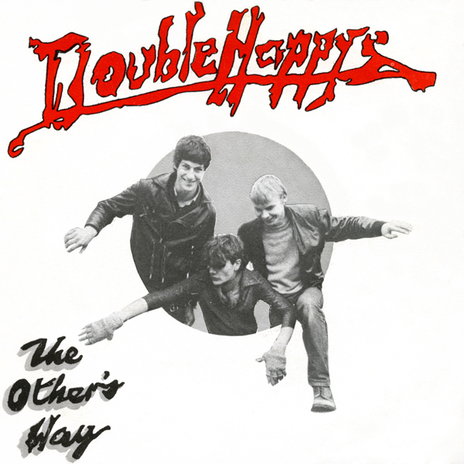
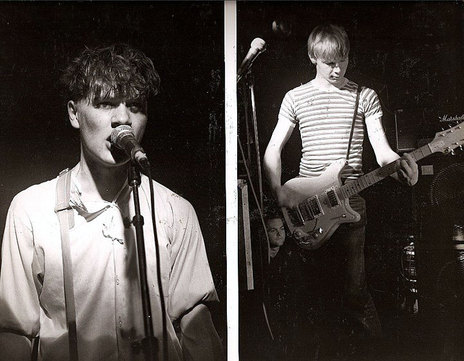
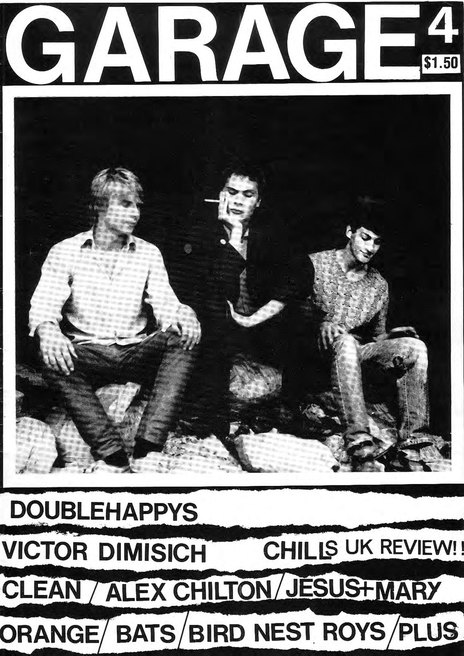
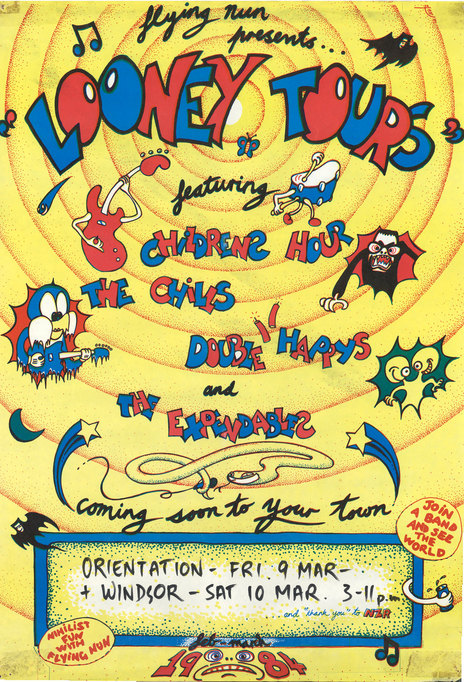
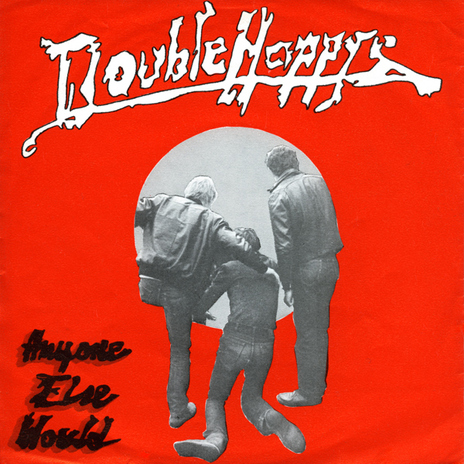
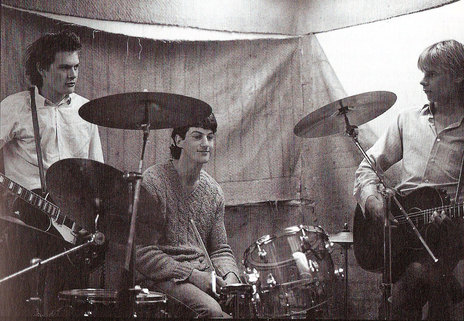
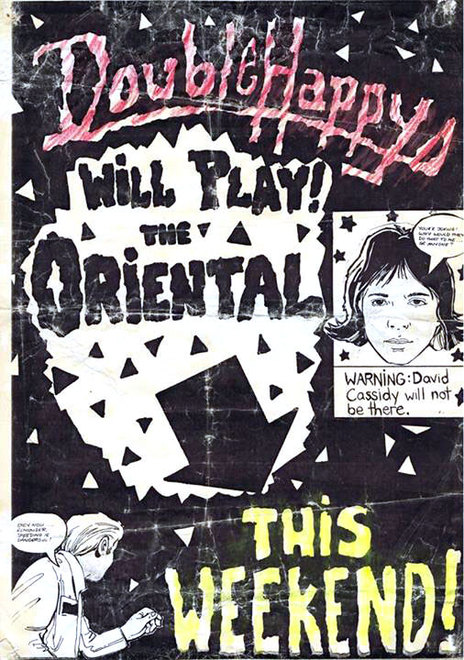
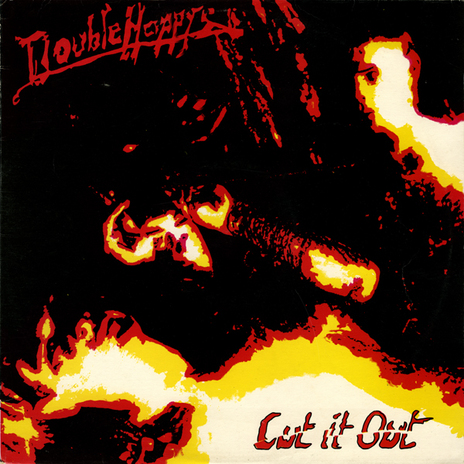
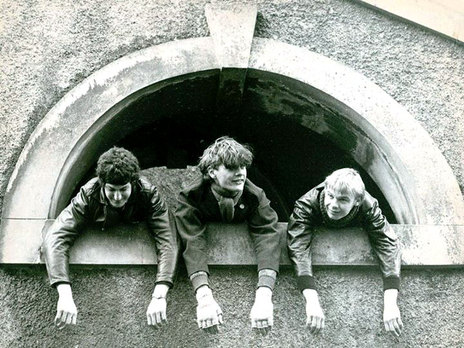

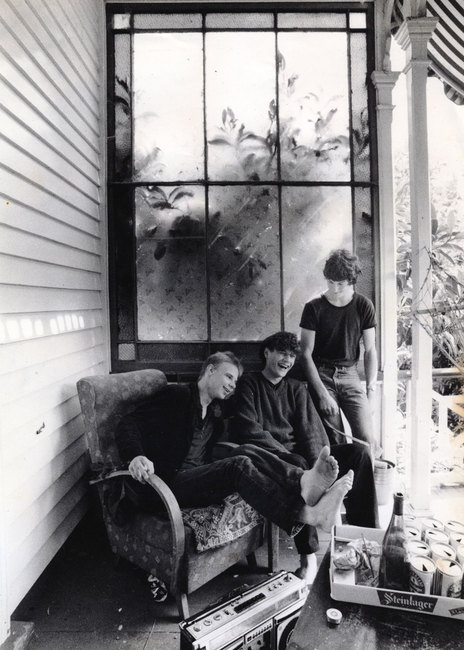
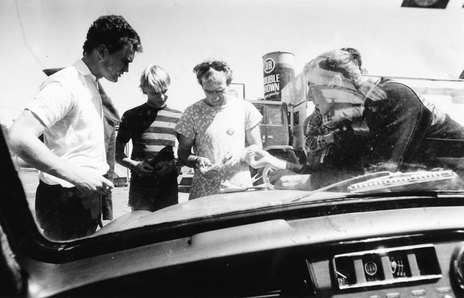
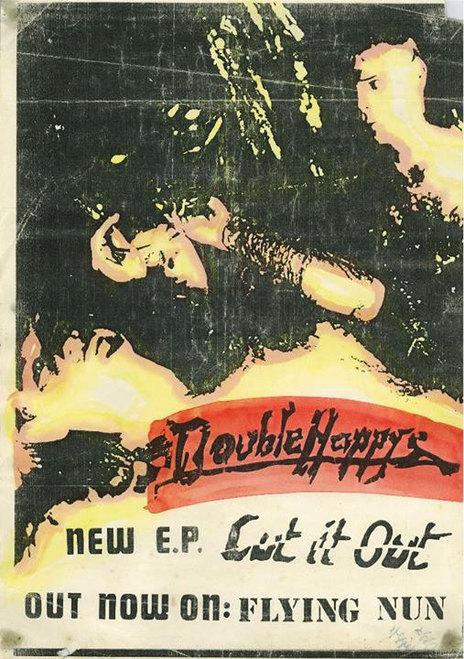
John Collie is an accomplished artist whose painting was used on The Verlaines’ Bird-Dog album.
Visit our sister site
NZ On ScreenMade with funding from
NZ On Air



